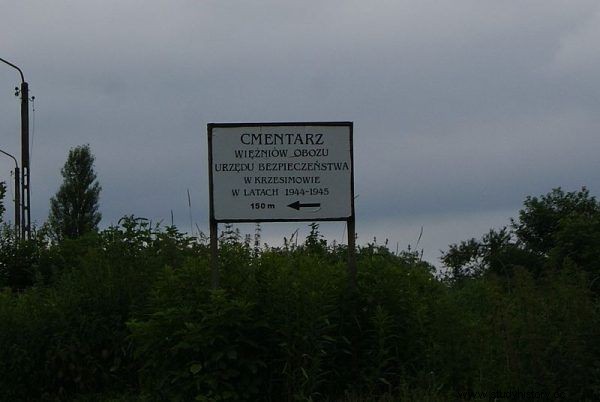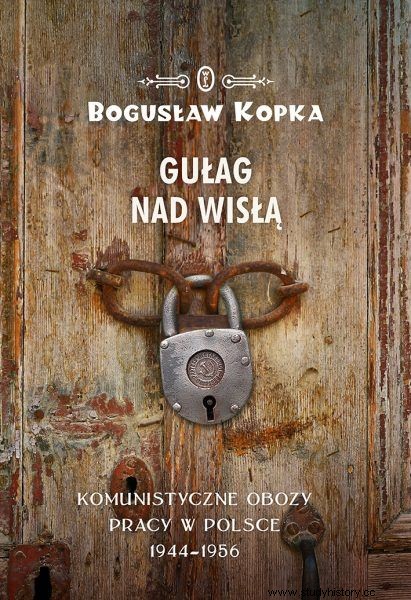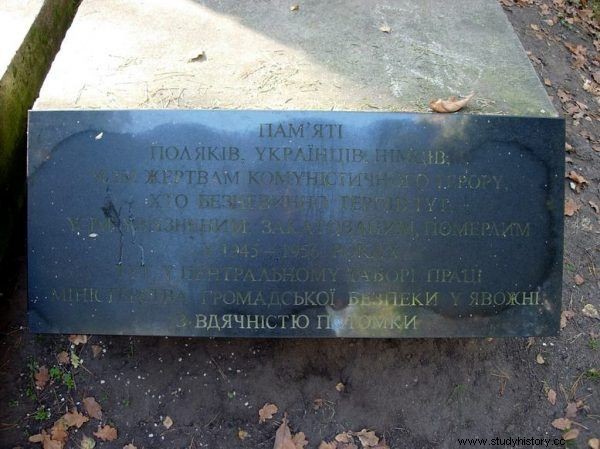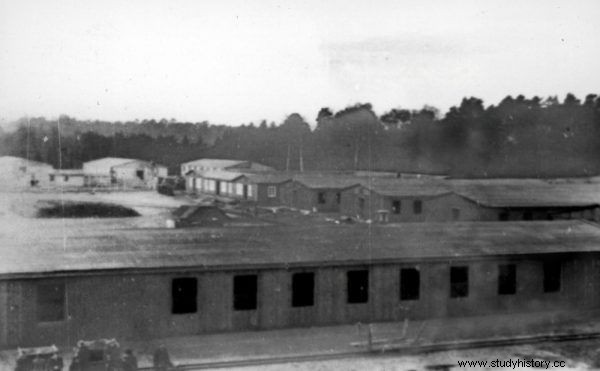Many Poles would still prefer not to talk about the existence of post-war camps. Discussion about their names - Polish? communist? Stalinist? - is far from being settled. The search for the guilty, however, often draws attention away from the most important - the fate of the prisoners. Do we even know how many there were?
The first camps established by communists were established in Poland in 1944. They were created by the NKVD, and the arrests included soldiers of the Polish Underground State, German prisoners of war and the population accused of collaborating with the Nazis. After a short stay, some of the inmates were sent further into Russia. Others were used, for example, to demolish industrial plants.
The network of centers organized by Soviet officers operated until the end of 1945. Then some of them were liquidated, and the rest - along with prisoners, the number of which could reach up to 50,000! - handed over to the local security apparatus. This one, inspired by an example from the East, was already building its own prison system at that time. Labor camps have become an integral part of it. In the years 1945–1950, there were 206 of them in Poland. How many people were there?
The first two thousand
"Nobody knows the exact numbers" - emphasizes Bogusław Kopka, a historian dealing with the history of the communist camps. Especially the beginnings of the network of centers are difficult to grasp:there was too much organizational chaos in them at that time. Various categories of prisoners were sent to the camps. Yes, Kopka in his latest book "Gulag on the Vistula" tells about the first of them, which was established in Krzesimów:
Created in October 1944 under the name of the Labor Camp of Political Criminals and Suspects, it was intended both for collaborators of the German occupier, Volksdeutsche, and the German population (e.g. German displaced persons from Bessarabia) , ordinary criminal criminals, as well as for soldiers of the Home Army, NSZ, Peasants' Battalions and prisoners of the Stalinist prison system . At least 2,037 people came to him, including the elderly, women and children .

There is a cemetery in Krzesimów where the deceased prisoners of the first security camp were buried.
Other facilities appeared soon after Krzesimów. They were created not only top-down - the biggest problem was the Department of Prisons and Camps of the Ministry of Public Security with the so-called "wild camps". They were established by arbitrary local power centers, and the MBP only gradually took control over them.
"The labor camps were concentrated in three regions on the north-south line:Upper Silesia - Central Poland - Pomerania and Kujawy" - reports Kopka. As the network expanded, the number of prisoners grew as well. In April 1945, according to the data stored in the Ministry of Public Security, there were 27,826 of them. In December - already 29,559.
In the following years - until 1947 - this number continued to grow. Father Józef Dębiński, who also studied the history of the security camps, emphasizes that it was then that they developed most dynamically. By the end of this period, the number had almost doubled in the spring of 1945. In March 1947, there were 57 714 inmates in the camps .
Volksdeutsche, prisoners and speculators
Who was sent to forced labor centers operating under the aegis of the Ministry of Public Security? Until 1949, they were mostly populated by Volksdeutsche. Prisoners of war were in second place in terms of numbers. Gradually, however, prisoners convicted of "economic crimes" began to come to the fore. Their appearance was associated with the appointment at the end of 1945 of the Special Commission to Combat Abuse and Economic Harm. Its powers also included sending "pests" to labor camps with a penalty of up to two years' imprisonment. As in the book "Gulag on the Vistula" says Bogusław Kopka, the number of sentences grew frighteningly:
In 1947, the Special Commission for Combating Fraud and Economic Harm sentenced 4,335 people to a labor camp, in 1948 - 5186, in 1949 - 9134. Most people sentenced by commission to camps for "illegal slaughter" and meat trade:in 1948 there were 314 of them, and in 1949 already 2119. During the nine years of its operation, the commission issued over 300,000 sentences, including 90,000 people sentenced to punishment by the camp work .

The largest group of prisoners with the verdicts of the Special Committee were sent to the Central Labor Camp in Jaworzno (to the Chrusty sub-camp). It was the largest of the existing centers in Poland. At the peak of its development, i.e. in March 1947, 19,932 people were staying in it and its sub-camps. Among them there were several hundred children - in the spring of 1948 there were 406 of them. “Overall, the camp in Jaworzno and its branches from 1945 to August 1949 over 24,000. prisoners " - Father Dębiński is enumerating.
It was to a special sub-camp in Jaworzno that the Ukrainians were deported as part of the "Vistula" operation. It was established in April 1947 by decision of the Politburo of the Polish Workers' Party. By December of the following year, when the last displaced persons left the camp, 3,871 people of Ukrainian nationality had passed through it.
The basis of Upper Silesian mining
What about prisoners of war who were transferred to Poles from the camps established by the NKVD? A large part of the prisoners taken over by our authorities ended up in… Upper Silesian mines. They were taken care of by the Central Board of the Coal Industry, which found itself in a crisis after the war - the Soviets deported as many as 15,000 Polish miners deep into the USSR.
CZPW used forced labor until 1950, when the repatriation of the Germans ended. In the first years of mining slaves there were tens of thousands each. As Bogusław Kopka lists:
At the end of December 1945, the number of POWs working in the mines exceeded 35,000, and by the end of 1946 it stabilized at 25,000–26,000. From 1948, that is from the moment of the commencement of the action of releasing prisoners, the "status of the obligated" in the CZPW forms was constantly decreasing.

In the camp in Jaworzno, there were over 3,000 Ukrainians displaced as part of the "Vistula" operation. In the photo there is a plaque commemorating the prisoners.
And so the "number of forced labor" prisoners on August 31, 1948 was 23,580, on August 1, 1949 only 4,846 (including 1,284 SS men). On February 19, 1950, there were still a total of 1,441 prisoners in the camps, and at the beginning of May, only 205 Germans remained in camp facilities in Silesia:203 civilians, one prisoner and one SS man.
Eighteen hundred death certificates
Can all this data be contained in one reliable number? "The total number of prisoners of the" Gulag on the Vistula "- including those who died in communist camps in People's Poland - is difficult to determine, mainly due to the lack of reliable sources, says Kopka. The researcher gives an estimated number of 300,000 inmates for the period 1944–1956. Father Dębiński is inclined to a higher number - for the years 1945–1950 alone he receives around 350,000 prisoners.
It is equally difficult to state the exact number of deceased. Partly because in some places… they just weren't registered. As an employee of the Registry Office wrote in December 1945:
Writing deaths to registers has not been effective yet. After further reflection, the Registry Office became convinced that the enrollment in the registers of such a large number of people who, in relatively short intervals of time, died in the local Cold Water Labor Camp, mentioning the causes of death, etc., could shed a negative light on the course of the relationship, what prevailed in Polish camps after liberation from the yoke of occupation .
The single numbers we know are shocking, however. Diseases, which the weakened organisms of prisoners were unable to fight effectively, took their toll. "Only in 1945, as many as 992 prisoners died at the COP Jaworzno as a result of an epidemic of typhus and typhoid fever," says Dębiński. Marta Wiesner, who was imprisoned in Auschwitz after the war, mentions 500 victims of typhus at the turn of July and August 1945.

In the post-German camp in Potulice in 1945-1950, more than half of the inmates were children under 15! The photo shows the construction of the camp for the German Resettlement Center in Potulice.
Even more inmates died in the Świętochłowice-Zgoda camp. As Kopka says:
It is estimated that eighteen to two and a half thousand people lost their lives in the camp in less than nine months of its existence. At the Registry Office in Świętochłowice, eighteen hundred death certificates signed by the camp commandant, Salomon Morel, have been preserved.
Even the then head of the Department of Prisons of the Ministry of Public Security, Lt. Col. Teodor Duda, judged Morel to be responsible for allowing the outbreak. He was punished for this by a three-day detention and a deduction of half of his salary .
Such punishments certainly did not mobilize the morale of the camp staff. Lack of hygiene measures and medical care, malnutrition, as well as bestial treatment by the guards - all this translated into a high mortality rate. In the camp in Jaworzno alone, 6,987 people (including 161 Ukrainians) died. What could the global death toll be like? Bogusław Kopka cautiously gives the figure of 25,000. But it seems to be the beginning of the balance sheet of a crime, the full extent of which is yet to be discovered.
Check where to buy the "Gulag on the Vistula. Communist labor camps in Poland 1944-1956 ”:
